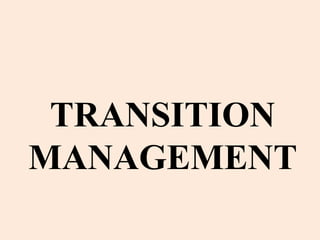
Transition management
- 2. TRANSITION • Transition psychology originated from work on bereavement, family crisis and depression. • Models of transition endeavour to describe how individuals respond to change, either in their own lives or environment. There are many types of change and varying degrees of impact. • Not all changes cause transitions. Most transitions are associated with significant life events - changes to the individual’s role or environment that require radical restructuring of the individual’s view of themselves and their world.
- 3. TRANSITION MANAGEMENT • Transition management is now a key aspect of any organization's change process. • Transition management is about what employees experience personally within themselves. It is concerned with helping employees let go of how things used to be and adapt to the way things are or are going to be. Managing transitions means helping employees to make a difficult process less stressful and disruptive for everyone.
- 4. SO WHAT TO DO? When change occurs, the actions taken by management can impede or enhance employees’ adaptation to change. It is vital to identify the ‘whats’ and the ‘hows’ of the proposed change and assess the impact on employees.
- 5. WHAT’S • strategy and principles • organisational structure • roles and responsibilities • reporting lines • budget responsibilities • individual capabilities • consultation process.
- 6. HOW’S • clear reasons for the change that employees can understand and believe • internal one-to-one communications • awareness and management of stress • emotional support • identifying aspects that individuals and the organisation need to ‘let go’.
- 7. The key issue for organisations is to increase transition awareness among its employees and managers at all levels. This will help to prepare employees for change that will occur at work (and in their home life). It will also help managers to manage and support employees during periods of organisational change.
- 8. 1. CLEAR VISION 2. ENDINGS 3. NEUTRAL ZONE 4. NEW BEGINNING Transition stages
- 9. Clear vision needs to be established when initiating change. STAGE-1 Top-level management must consider all those who will be affected through the changes.
- 10. Dealing with Transition It is important to understand the stages of Transition and the impact of each stage. Prepare teams for transition and to facilitate a successful transition process for them. STAGE-2
- 11. STAGE-3 Anxiety rises and motivation falls Productivity suffers Confusion and miscommunication IMPORTANT TO MANAGE THIS ZONE
- 12. STAGE-4 Be consistent Celebrate the successes of new identity Figure out what has actually changed Consider possibilities in a new light
- 13. IMPLICATIONS • Management style must adapt to different phases of the change process. Launching a change may require a firm, directive style, whereas the transition will require a more supportive and consultative approach. • Trust is a key component for all employees going through the transition cycle. Employees need to trust their senior management team’s competence, credibility and motives for launching any change.
- 14. If the transition process is not effectively managed then an organisation is likely to experience some or all of the following: • increased sickness absence • reduced/poor performance • loss of creativity and initiative • increased grievances • resignations.
- 15. Preparing Employees for Transition There are a number of initiatives and activities that an organisation can employ as part of their plan for transition, such as: • engage in real two-way dialogue, not one-way communication • understand the organisational change from the employee’s perspective • align the organisations human resources systems to support the employees in transition • allow for individual differences in employees capacity to cope with change • concentrate on providing adequate training, mentoring and coaching for employees affected by change • equip managers and employees with the personal and leadership skills to manage change and the transition process.
- 16. THANK YOU!!
